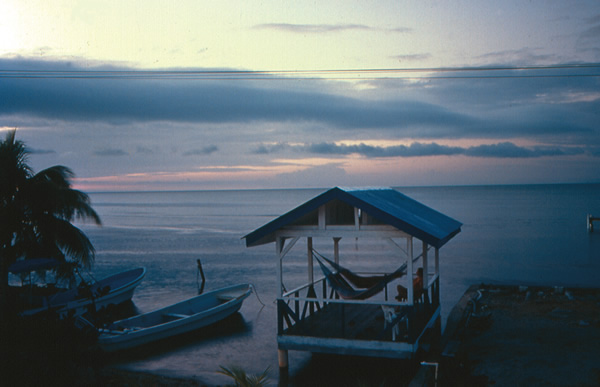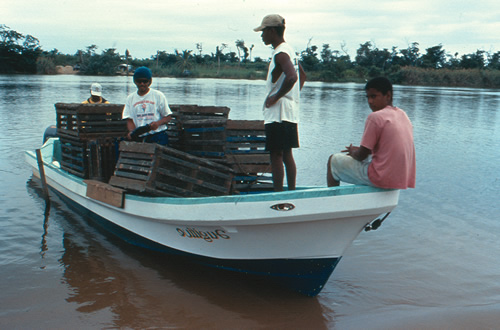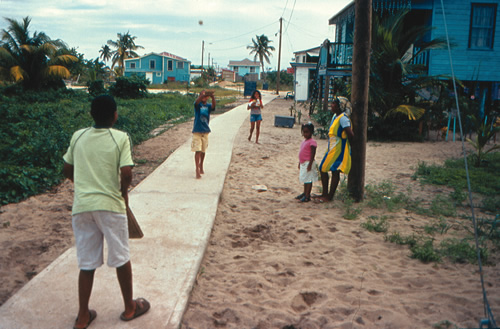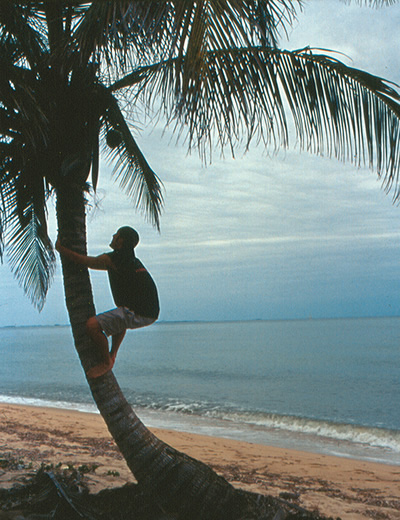Explore a Reef Hideaway in Belize
The Placencia Peninsula Offers Affordable Adventures
Article and photos by Daniel Gabriel
 |
| At sunset, the gazebo hammocks and the Caribbean beckon from the verandah of Placencia’s Paradise Vacation Hotel. |
Sure, you’ve heard of Belize. Biggest barrier reef in the western hemisphere. All those great snorkeling and diving sites at Ambergris and Caye Caulker, right? All true, but to focus
only on the best-known of the Belizean cayes is to miss out on one of the gems of this breathtakingly diverse country’s world-class coastline: the Placencia Peninsula. This 15 mile-long finger of land has been called “the
cay you can drive to.”
The Placencia Peninsula has the same soft sand as the islands, the same swaying palm trees and deep blue Caribbean waters . . . yet it doesn’t feel as if it has sacrificed its soul
for tourism. True, there are a few discreet luxury resorts tucked under the palm fronds halfway up the peninsula, and a healthy cross-section of international nomads fill the wooden guesthouses of the village at the southern tip, but
the local ambience remains laid-back. Besides, its 14-mile beach is the longest in the country, providing plenty of room to get lost along it.
The Barrier Reef — a stunning 175 mile-long strand of waving coral that is home to more than 80 species of fish and countless varieties of plant life — lies 45 minutes offshore. Boats
run daily to dive sites at the Silk Cayes or Laughing Bird Caye (recently designated a UNESCO World Heritage Site). Our family thoroughly enjoyed Ranguana Caye, where the day outing included barbecued red snapper for lunch and plenty
of snorkeling spots for non-divers. We saw multi-colored fan coral, stands of brain coral, darting schools of parrotfish — even a manta ray.
If you’re a diver, so much the better. Because the Barrier Reef separates further from the mainland as it approaches Placencia, creating huge patches of coral reef with channels dropping
to 100 feet and then rising again into shoals and cayes. This provides both shallow spots for snorkeling and easy access to deep water sites for calm water diving year-round. The area is also noted for viewing migrating whale sharks.
Other appealing daily tour options are to Cockscomb Basin Wildlife Sanctuary, which is the world’s only jaguar preserve; Red Bank, which is home to a seasonal population of rare scarlet
macaws; or outings to the Mayan ruins of Nim Li Punit or Labaantun.
We also took an excursion south along the coast to Monkey River. Part of this trip runs through mangrove swamps on the far side of Placencia Lagoon, where dolphins and manatees cavort in
the late afternoon sun. Monkey River Town — once the terminus of a banana railroad before blight destroyed the crops — is now a fading, forgotten Garinagu village that relies on medicinal herbs from the surrounding jungle for
most of its basic medical needs. The river itself features a variety of exotic birdlife. When we hiked ashore, a tiny machete-hacked path led us past jaguar and tapir tracks, kapok trees and towering royal palms, to a hidden inland
bamboo grove.
 |
| Lobster fishermen return with their catch to nearby Monkey River Village. |
When it was time to eat, we could simply stroll Placencia’s “sidewalk” (“the world’s narrowest main street,” according to the Guinness Book of World Records)
and choose between the many local eateries, serving anything from seafood to vegetarian to homemade ice cream. Papaya and seaweed shakes made a great mid-afternoon refresher.
 |
| Local kids playing on world's narrowest street. |
Changes have been coming to Placencia, of course. In the last few years a well has been dug, which means a steady water supply rather than having to depend on rainwater collected on roofs,
and two years ago phone service arrived. There’s even an Internet cafe. But the only road in is still dirt, and fishing boats still go out every day, and tiny Wallen’s Market is still the biggest store on the peninsula.
 |
| Author climbing palm tree. |
Probably the largest recent changes were wrought by Hurricane Iris, which scored a direct hit on Placencia in October 2001. New visitors will hardly notice the aftermath of damage, but longtime
residents bemoan the thousands of downed palm trees and the fact that, for the first time, folks are building in concrete, not the traditional wood. Despite it all, I’m betting on Placencia to keep its welcoming warmth for many
seasons to come.
Belize Resources
Getting There: Continental (via Houston) and American Airlines (via Miami and Dallas) make regular flights into Goldson Airport, just outside Belize City. There is little reason to linger
in the city itself.
From Belize City, there are three routes to Placencia. Easiest, and most expensive, is to fly with Maya Island Air or Tropic Air.
There are multiple flights each day, lasting 30-45 minutes and costing about $70.
To see a bit of the country — including the verdant mountainous Hummingbird Highway — drive or bus it via Belmopan and Dangriga.
An alternate land route — useful to avoid the dirt road stretch or if you’ve missed the direct Placencia bus — is to bus south from Dangriga toward Punta Gorda. Get off in Independence/Mango
Creek and catch a 20-minute boat ride across the Lagoon to Placencia.
Accommodations: Lodging options are plentiful. If it’s an upscale, secluded resort that you want, try the Victorian-style Kitty’s Place Beach Resort.
It’s much more convenient to stay in the village at the southern tip of the peninsula. Of the scattered guesthouses, two are most appealing: Sun ‘n’ Sea Cabanas offers modern cabins in a superb location — right on the beach at the tip of the peninsula. Paradise Vacation Hotell includes a spacious upstairs verandah, kitchen facilities, and a private gazebo with hammocks, all overlooking the Harbor.
Tours: Upscale resorts offer their own tours. Quality is high, but so is the price. Try checking out the dive shops near the co-op at the beach end of the sidewalk. Both Natural Mystic and our favorite, Nite Winds , offer comparable deals. For example, Monkey River trips or a half-day dive/snorkel on the Reef.
For adventures to Mayan ruins, horseback riding, caving, barrier reef diving, and more your best bet is Cave's Branch Adventure Tours.
Maps and Guidebooks: The only decent available map of Belize is put out by International Travel Maps (U.S. travel stores and occasionally available cheaper in Belize). Both The Rough Guide to Belize and Lonely Planet Belize (Travel Guide) offer effective Belize adventure guides, with a slight nod going to Rough Guide for thoroughness. For cultural background, nothing beats Insight Guides: Belize. For more on options in see the Belize tourism. website |
Daniel Gabriel is the director of Writers and Artists in the Schools Program in Minnesota.
|
